Contour Maps for Simultaneous Increase in Yield Strength and Elongation of Hot Extruded Aluminum Alloy 6082
Abstract
1. Introduction
2. Materials and Methods
2.1. Description of AA6082
2.2. Conditional Average Estimator Artificial Neural Network (CAE ANN)
2.3. Formation of the Database
3. Results of Multidimensional Analysis by CAE NN
3.1. Relationships in Which One Property Predominantly Increases and the Other Decreases
3.2. Relationships with a Predominately Simultaneous Increase of Both Properties
4. Discussion
5. Conclusions
- Artificial intelligence methods, especially ANNs, could be a potentially useful tool for revealing complex relationships in the production of metallic alloys, as the presented results show.
- Considering the obtained analysis results, a further simultaneous increase of yield strength and elongation can be achieved.
- The results of the analyses showed complex influences of chemical composition (Si, Mg, Mn, and Fe) and extrusion process parameters (ram speed and extrusion ratio) on mechanical properties (yield strength and elongation). The first part of the analyses showed the relationships in which, when the input parameters are changed, there is a simultaneous increase in one property and a decrease in the other. The second part of the analyses revealed a relationship where there is a simultaneous increase in both properties when the influential parameters are changed. These observations are new compared to similar published studies and constitute the novelty of the study.
- When analyzing the influences of chemical composition and ram speed on yield strength and elongation, the highest values for yield strength and elongation were obtained at a ram speed of about 7–11 mm/s, while the values for Mn and Si were both in the range of about 0.41–0.53 and 0.8–1.1 wt.%, respectively.
- The decrease in the values of yield strength and elongation was observed at higher values of ram speed, above 15 mm/s. However, the decrease in the values of yield strength and elongation with increasing values for ram speed depends on the content of Si, Mg, Fe, and Mn.
- When analyzing the effects of chemical composition and extrusion ratio on yield strength, the values for yield strength were highest for an extrusion ratio of 13–15. The values of elongation were highest for an extrusion ratio in the range of 17–20 and continued to increase with the increasing values of the extrusion ratio in the range with low predictive confidence.
- The results showed areas where both yield strength and elongation values increased simultaneously. The ranges were at a ram speed in the range of 7–11 mm/s and at a content of 1.1 wt.% Si, 0.85 wt.% Mg, 0.4 wt.% Fe, and 0.54 wt.% Mn, where the values for yield strength and elongation were in the range of 324–326 MPa and 12.2–12.5%, respectively.
- The values for ram speed from the different analyses of the influences of the chemical elements, where high values for the yield strength and elongation were found, were in the range of 7–11 mm/s. In the analysis of the complex influences of chemical composition and extrusion ratio, the high values for yield strength coincided with the value of the extrusion ratio of around 12–15. However, in this range, the values for elongation were generally in the middle range.
- The contour maps presented were generated by CAE ANN using data from an actual industrial production. Confirmation or rejection of the reliability (effectiveness/correctness) of the proposed approach will be found by considering the relationships of the presented contour maps in everyday industrial production and by the response of the professional scientific research community.
Author Contributions
Funding
Institutional Review Board Statement
Informed Consent Statement
Data Availability Statement
Acknowledgments
Conflicts of Interest
References
- Hägele, N.; Sonsino, C.M. Structural durability design recommendations for forged automotive aluminium chassis components submitted to spectrum and environmental loadings by the example of a tension strut. Int. J. Fatigue 2014, 69, 63–70. [Google Scholar] [CrossRef]
- Mistakidis, E.S.; De Matteis, G.; Formisano, A. Low yield metal shear panels as an alternative for the seismic upgrading of concrete structures. Adv. Eng. Softw. 2007, 38, 626–636. [Google Scholar] [CrossRef]
- Martiessen, W.; Warlimont, M. Springer Handbook of Condensed Matter and Materials Data; Springer: Berlin/Heidelberg, Germany, 2005. [Google Scholar]
- Lendvai, J. Precipitation and strengthening in aluminium alloys. Mater. Sci. Forum. 1996, 217–222, 43–56. [Google Scholar] [CrossRef]
- Hirth, S.M.; Marshall, G.J.; Court, S.A.; Lloyd, D.J. Effects of Si on the aging behaviour and formability of aluminium alloys based on AA6016. Mater. Sci. Eng. A 2001, 321, 452–456. [Google Scholar] [CrossRef]
- Wang, E.R.; Hui, X.D.; Wang, S.S.; Zhao, Y.F.; Chen, G.L. Improved mechanical properties in cast Al–Si alloys by combined alloying of Fe and Cu. Mater. Sci. Eng. A 2010, 527, 78–84. [Google Scholar] [CrossRef]
- Vončina, M.; Kores, S.; Mrvar, P.; Medved, J. Effect of Ce on solidification and mechanical properties of A360 alloy. J. Alloy. Compd. 2011, 509, 7349–7355. [Google Scholar] [CrossRef]
- Naglič, I.; Smolej, A.; Doberšek, M.; Mrvar, P. The influence of TiB2 particles on the effectiveness of Al-3Ti-0.15C grain refiner. Mater. Charact. 2008, 59, 1458–1465. [Google Scholar] [CrossRef]
- Žbontar, M.; Petrič, M.; Mrvar, P. The influence of cooling rate on microstructure and mechanical properties of AlSi9Cu3. Metals 2021, 11, 186. [Google Scholar] [CrossRef]
- Birol, Y. The effect of processing and Mn content on the T5 and T6 properties of AA6082 profiles. J. Mater. Proc. Technol. 2006, 173, 84–91. [Google Scholar] [CrossRef]
- Zhang, B.; Baker, T.N. Effect of the heat treatment on the hot deformation behaviour of AA6082 alloy. J. Mater. Proc. Technol. 2004, 153–154, 881–885. [Google Scholar] [CrossRef]
- Garrett, R.P.; Lin, J.; Dean, T.A. An investigation of the effects of solution heat treatment on mechanical properties for AA 6xxx alloys: Experimentation and modelling. Int. J. Plast. 2005, 21, 1640–1657. [Google Scholar] [CrossRef]
- Zhang, L.Y.; Jiang, Y.H.; Ma, Z.; Shan, S.F.; Jia, Y.Z.; Fan, C.Z.; Wang, W.K. Effect of cooling rate on solidified microstructure and mechanical properties of aluminium-A356 alloy. J. Mater. Proc. Technol. 2008, 207, 107–111. [Google Scholar] [CrossRef]
- Zhang, X.H.; Su, G.C.; Ju, C.W.; Wang, W.C.; Yan, W.L. Effect of modification treatment on the microstructure and mechanical properties of Al-035%Mg-7.0%Si cast alloy. Mater. Des. 2010, 31, 4408–4413. [Google Scholar] [CrossRef]
- Fjeldbo, S.K.; Li, Y.; Marthinsen, K.; Furu, T. Through-process sensitivity analysis on the effect of process variables on strength in extruded Al–Mg–Si alloys. J. Mater. Proc. Technol. 2012, 212, 171–180. [Google Scholar] [CrossRef]
- Sjolander, E.; Seifeddine, S. The heat treatment of Al-Si-Cu-Mg casting alloys. J. Mater. Proc. Technol. 2010, 210, 1249–1259. [Google Scholar] [CrossRef]
- Butkovich, J.N.; Hashash, Y.M.A. Neural network material model enhancement: Optimisation through selective data removal. AI EDAM 2007, 21, 61–72. [Google Scholar] [CrossRef]
- Flood, I. Performin calculus operations on poorly understood engineering functions using neural networks. AI EDAM 2009, 9, 419–426. [Google Scholar]
- Dobrzański, L.A.; Sitek, W. Designing of the chemical composition of constructional alloy Steels. J. Mater. Proc. Technol. 1999, 89-90, 467–472. [Google Scholar] [CrossRef]
- Guo, Z.; Sha, W. Modelling the correlation between processing parameters and properties of maraging steels using artificial neural network. Comput. Mater. Sci. 2004, 29, 12–28. [Google Scholar] [CrossRef]
- Capdevila, C.; Garcia-Mateo, C.; Caballero, F.G. Garcıa de Andres, C. Neural network analysis of the influence of processing on strength and ductility of automotive low carbon sheet steels. Comput. Mater. Sci. 2006, 38, 192–201. [Google Scholar] [CrossRef][Green Version]
- Večko, P.T.; Peruš, I.; Kugler, G.; Terčelj, M. Towards improved reliability of the analysis of factors influencing the properties on steel in industrial practice. ISIJ Int. 2009, 49, 395–401. [Google Scholar] [CrossRef][Green Version]
- Terčelj, M.; Fazarinc, M.; Kugler, G.; Peruš, I. Influence of the chemical composition and process parameters on the mechanical properties of an extruded aluminium alloy for highly loaded structural parts. Constr. Build. Mater. 2013, 44, 781–791. [Google Scholar] [CrossRef]
- Mrówka, N.G.; Sieniawski, J.; Wierzbińska, M. Intermetallic phase particles in 6082 aluminium alloy. Arch. Mater. Sci. Eng. 2007, 28, 69–76. [Google Scholar]
- Liu, Y.L.; Kang, S.B.; Kim, H.W. The complex microstructures in as-cast Al-Mg-Si alloy. Mater. Lett. 1999, 41, 167–272. [Google Scholar] [CrossRef]
- Mrówka, N.G.; Sieniawski, J. Influence of heat treatment on the microstructure and mechanical properties of 6005 and 6082 aluminium alloys. J. Mater. Proc. Technol. 2005, 163, 367–372. [Google Scholar] [CrossRef]
- Mrówka, N.G.; Sieniawski, J. Effect of heat treatment on tensile and fracture toughness properties of 6082 alloy. J. Achiev. Mater. Manuf. Eng. 2009, 32, 162–170. [Google Scholar]
- Grabec, I.; Sachse, W. Synergetics of Measurement, Prediction and Control; Springer Series in Synergetics; Springer: Berlin/Heidelberg, Germany, 1997. [Google Scholar]
- Perus, I.; Poljansek, K.; Fajfar, P. Flexural deformation capacity of rectangular RC columns determined by the CAE method. Earthq. Eng. Struct. Dyn. 2006, 35, 1453–1470. [Google Scholar] [CrossRef]
- Specht, D.F. A general regression neural network. IEEE Trans. Neural Netw. 1991, 2, 568–576. [Google Scholar] [CrossRef]
- Humpreys, F.J.; Hatherly, M. Recrystalization and Related Annealing Phenomena; Elsevier: Oxford, UK, 2004. [Google Scholar]
- Poletti, C.; Wójcik, T.; Sommitsch, C. Hot deformation of AA6082 containing fine intermetallic particles. Metall. Mater. Trans. A 2012, 44, 1577–1586. [Google Scholar] [CrossRef]

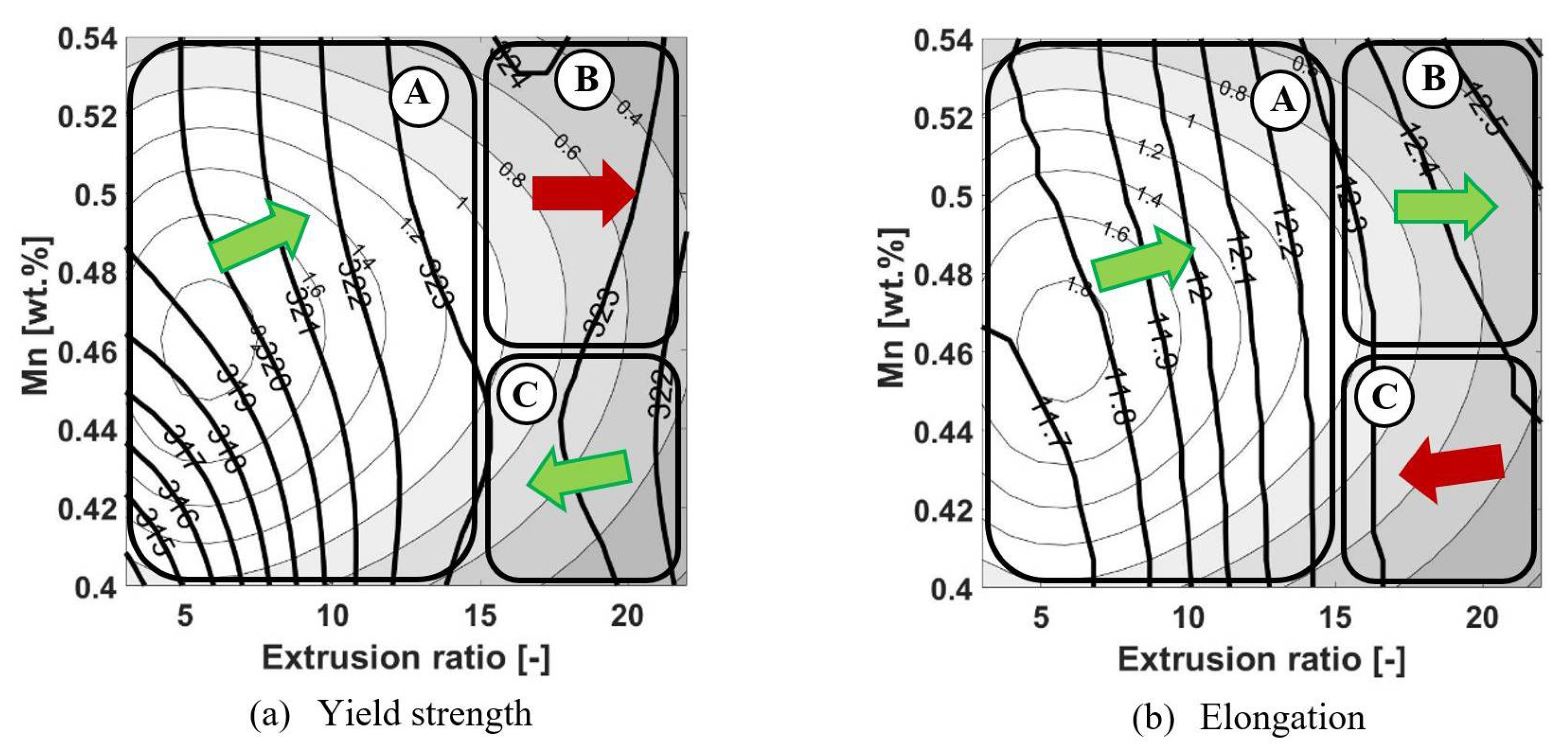
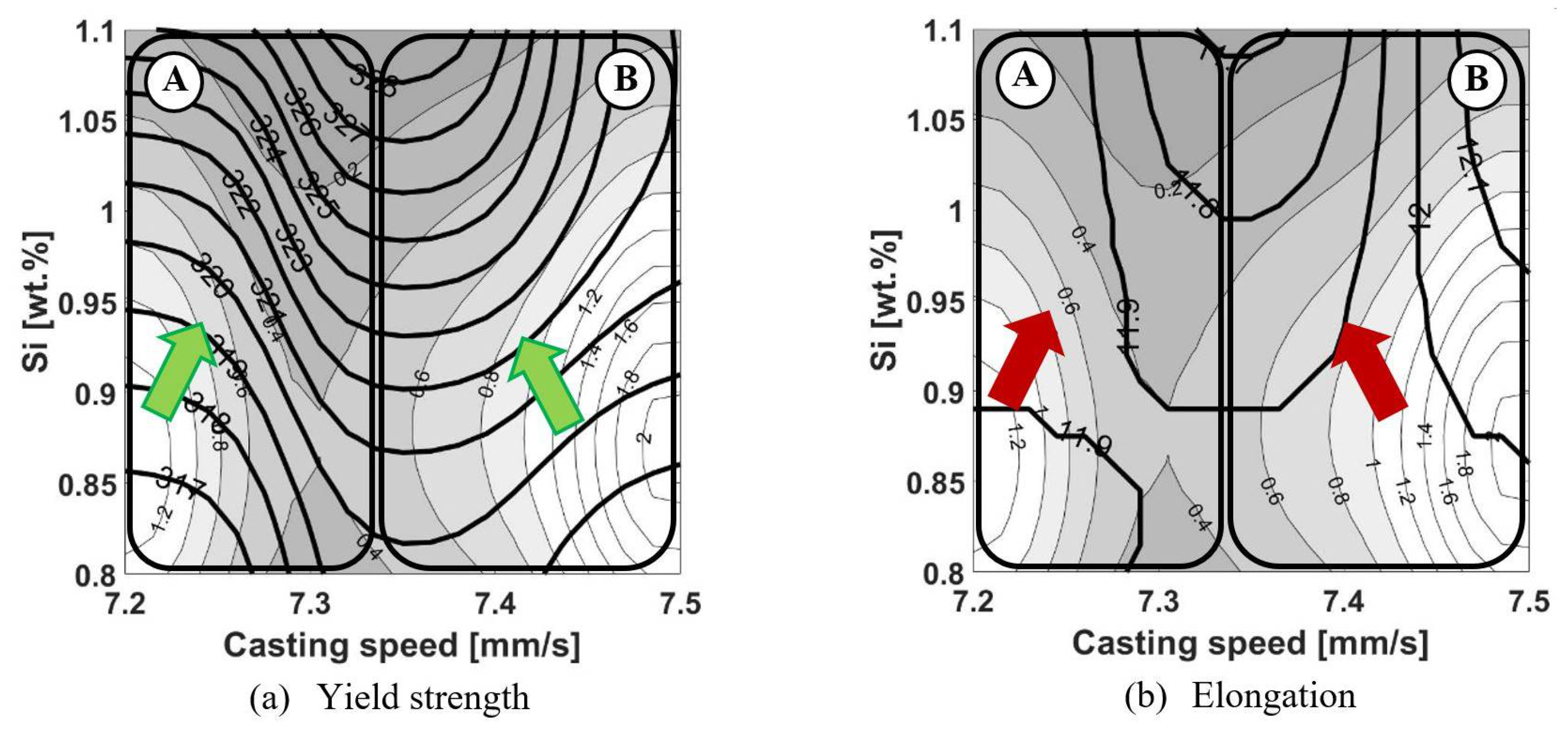
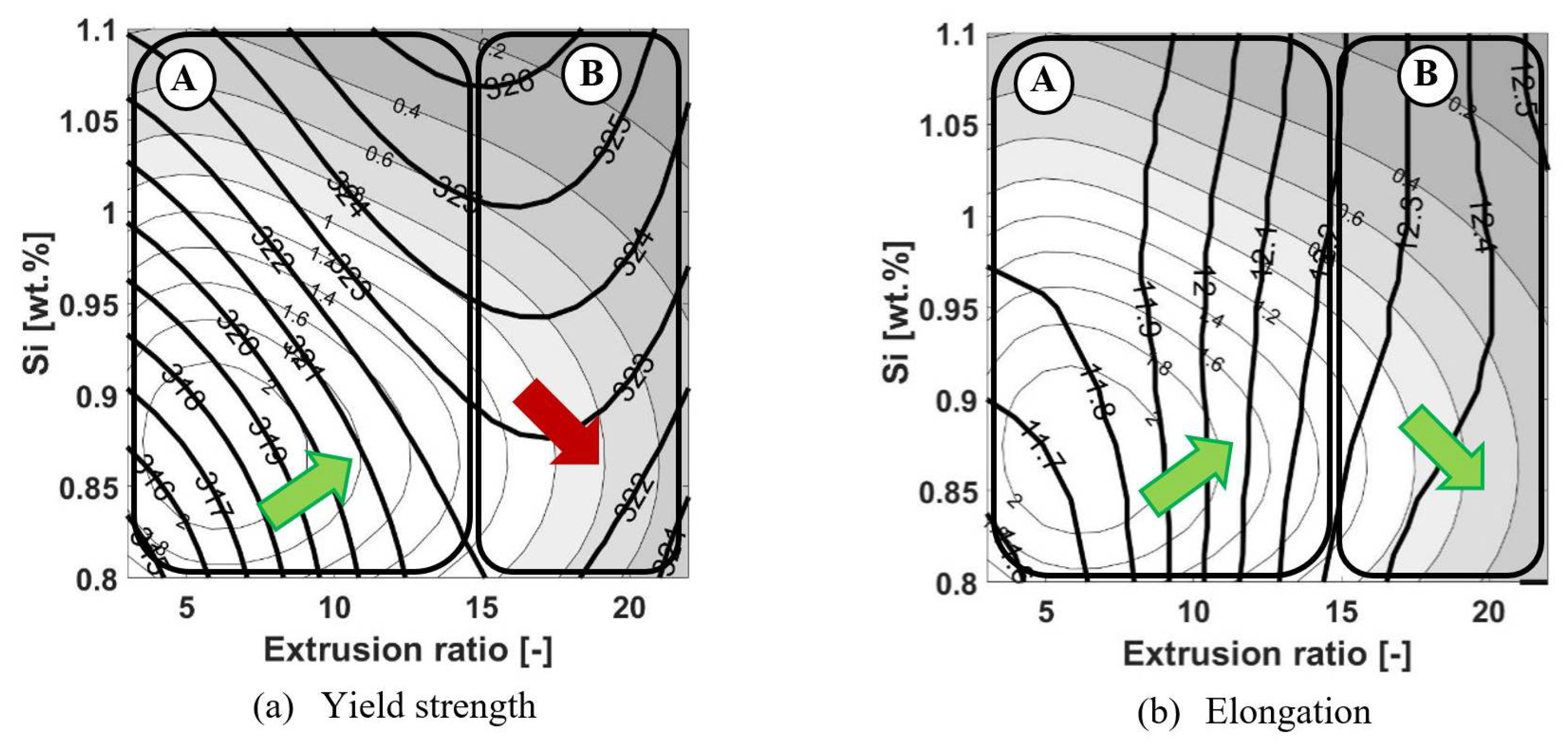
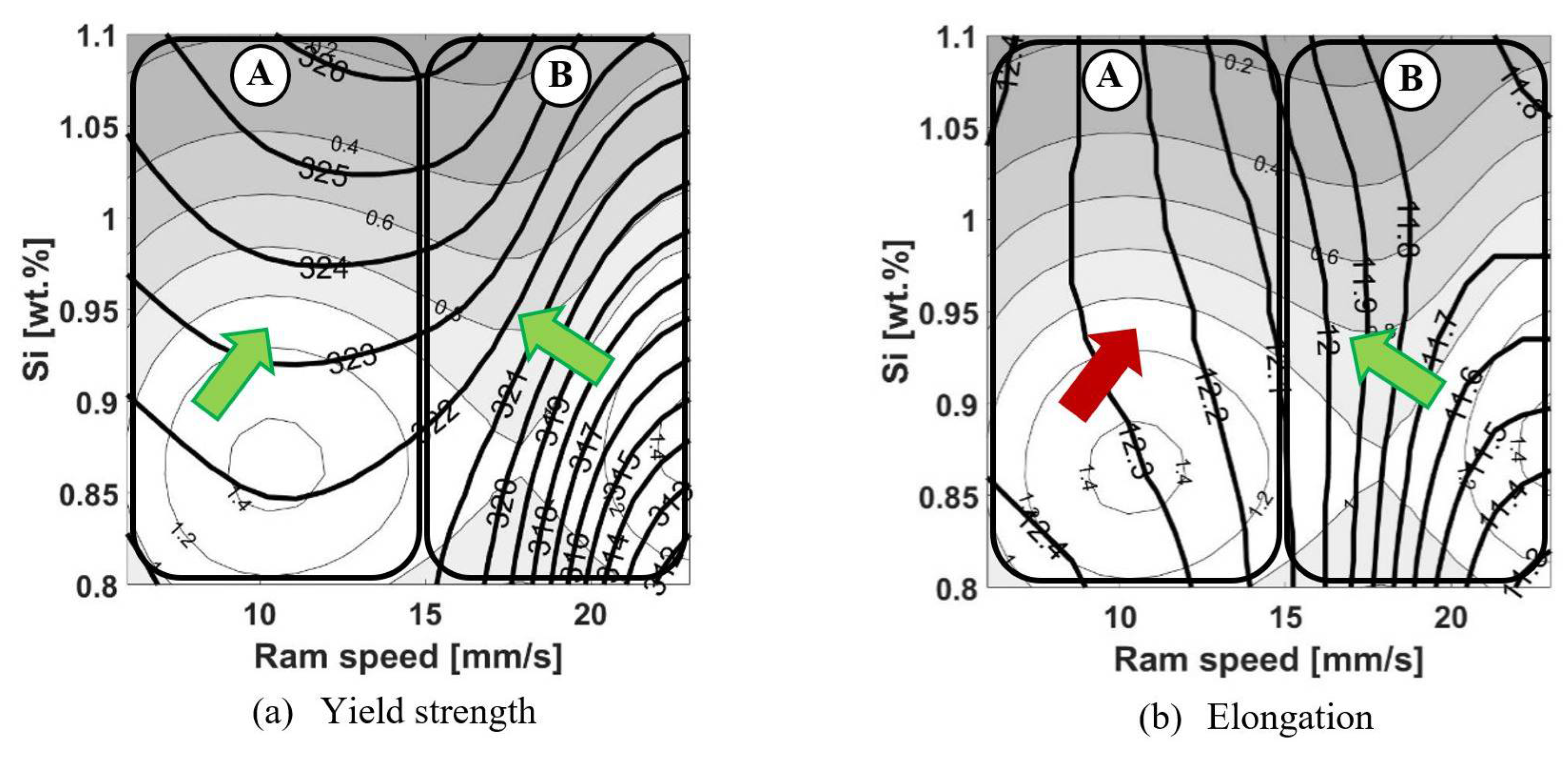
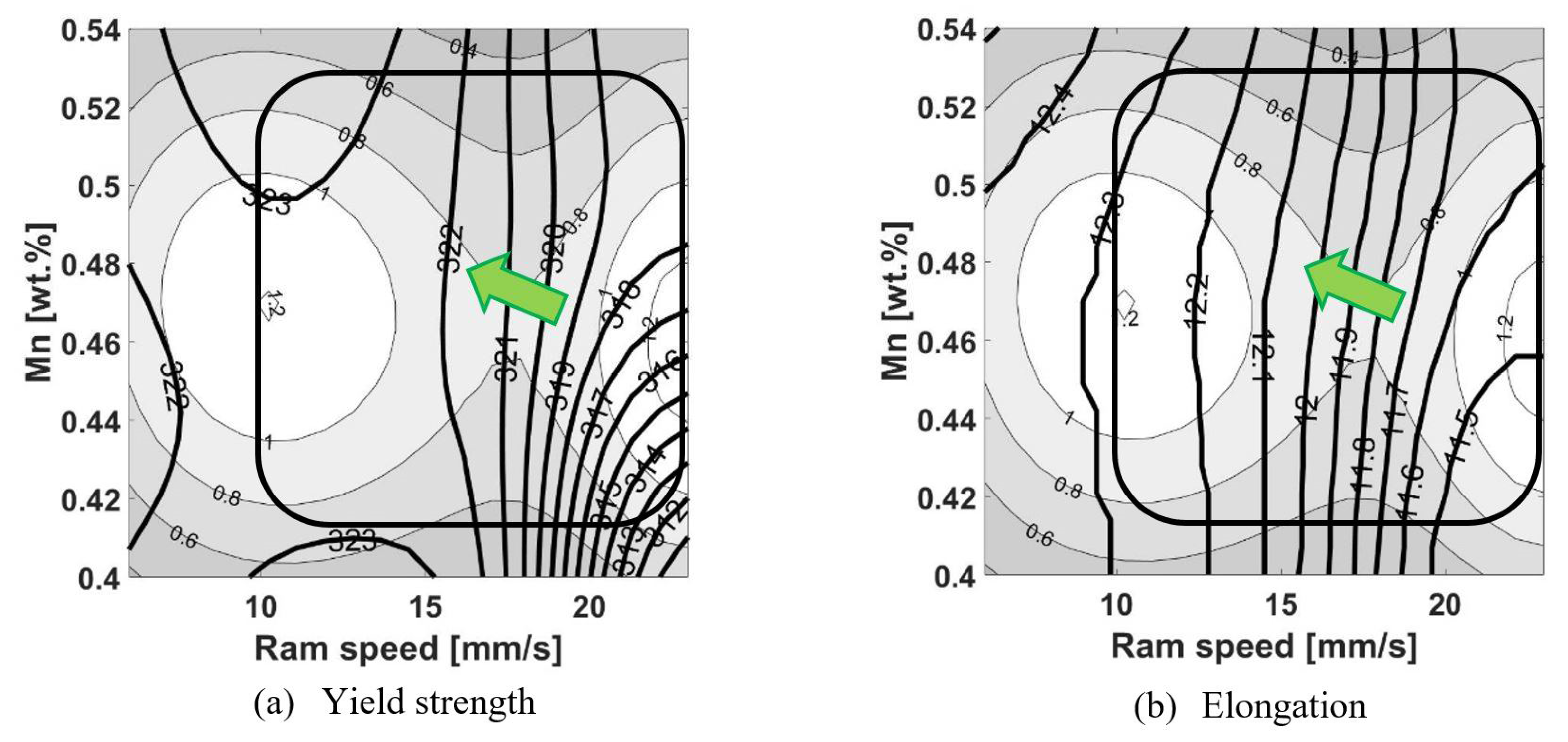
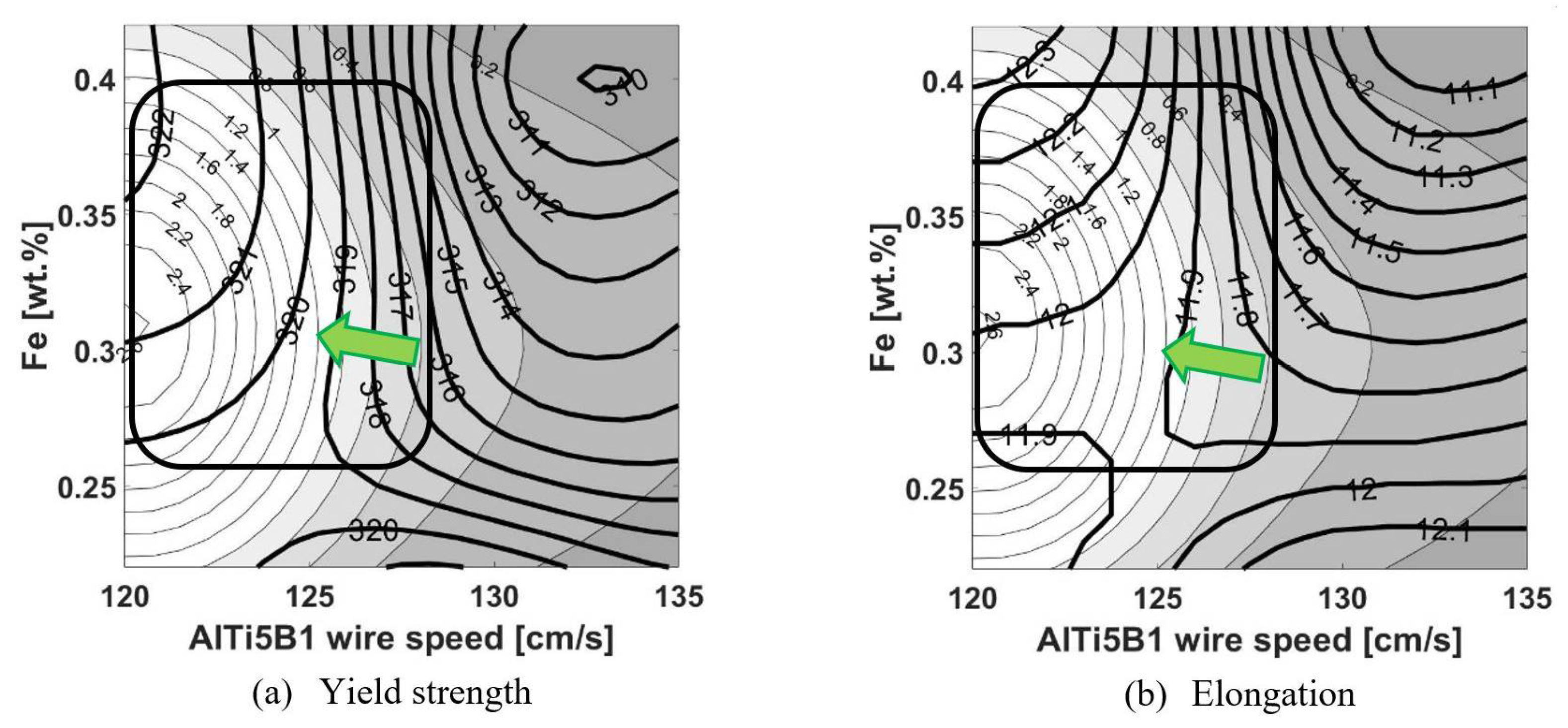
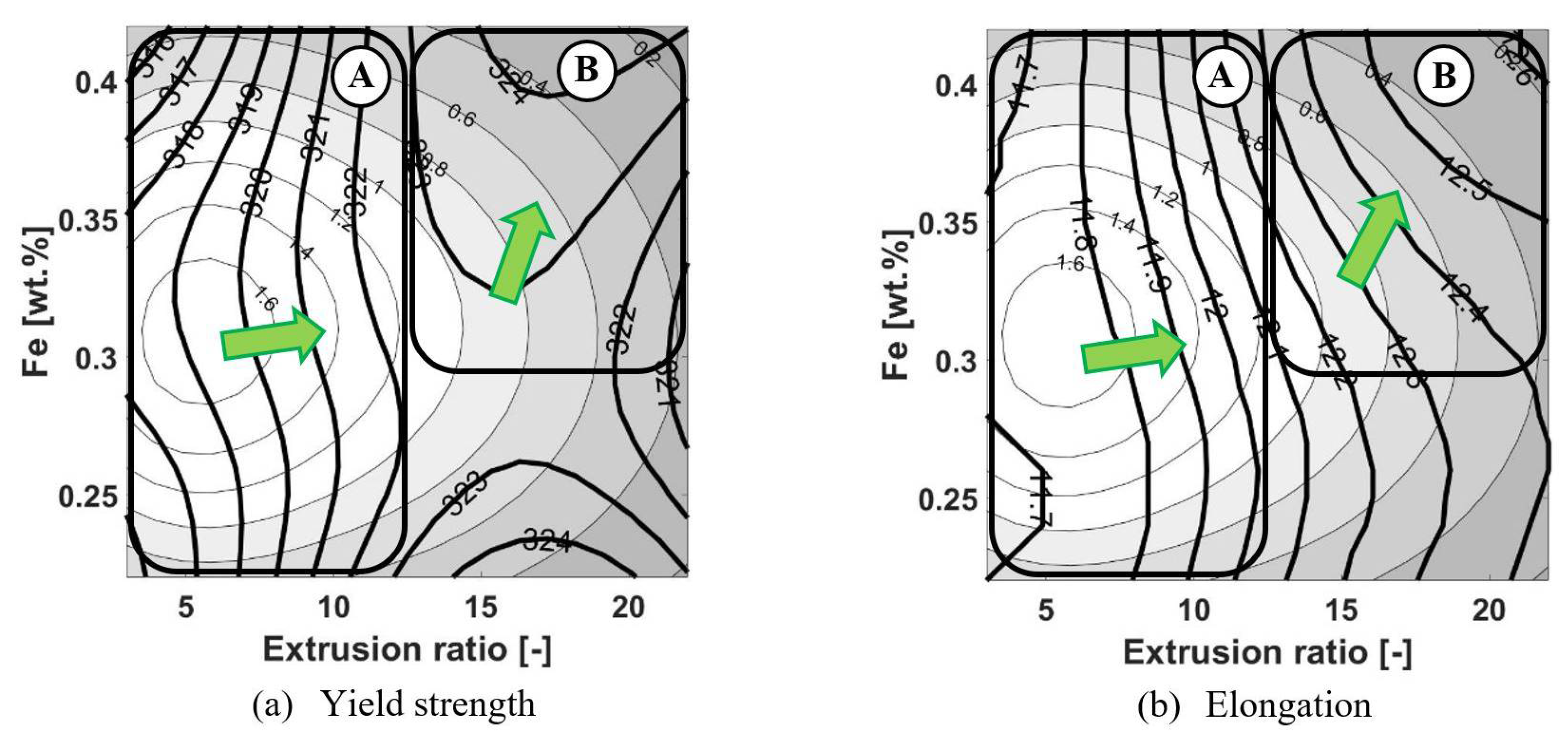
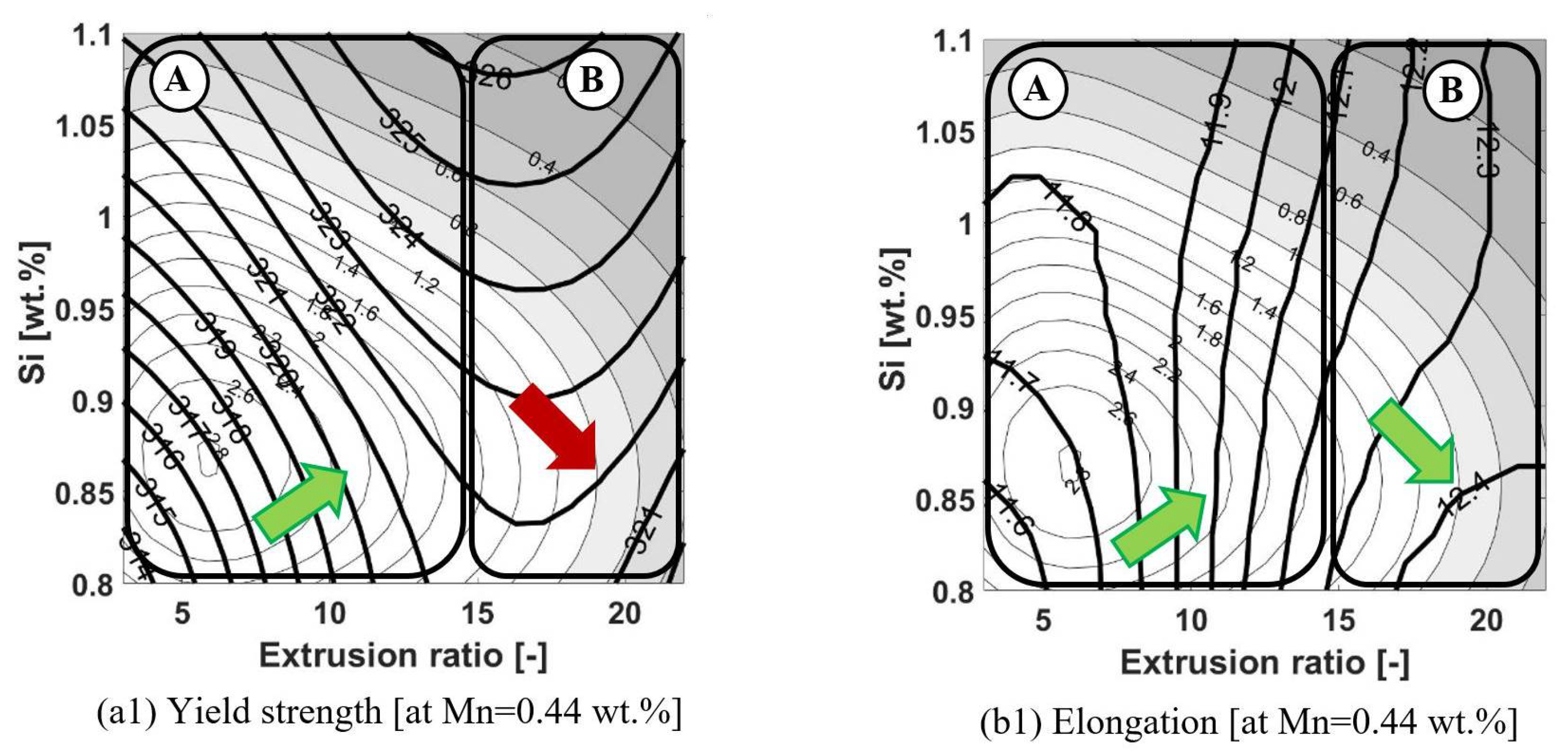
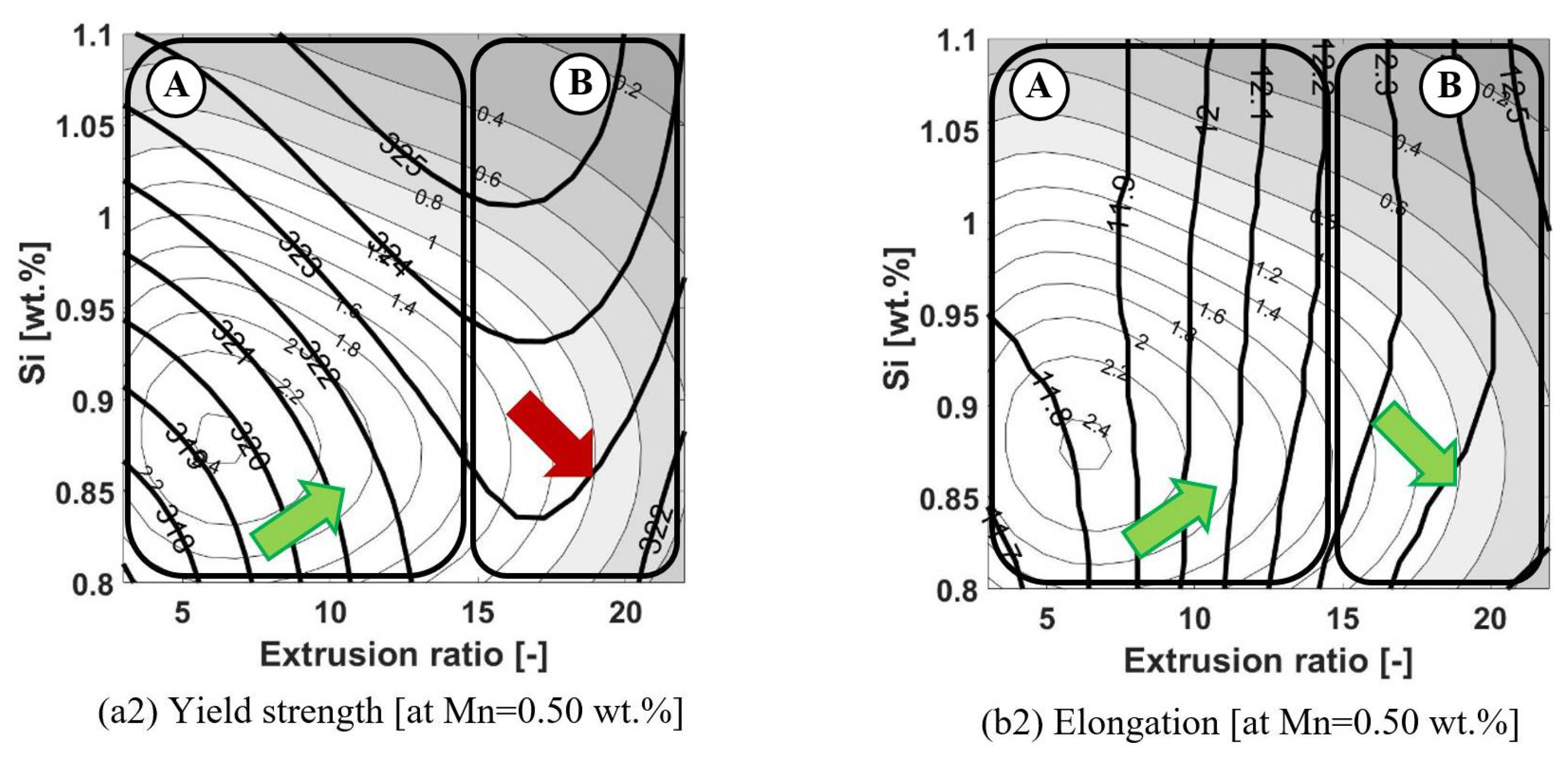
| Fe (wt.%) | Si (wt.%) | Mn (wt.%) | Mg (wt.%) | Cu (wt.%) | Zn (wt.%) | Cr (wt.%) | Ti (wt.%) | Others (wt.%) |
|---|---|---|---|---|---|---|---|---|
| 0.0–0.50 | 0.70–1.30 | 0.40–1.00 | 0.60–1.20 | 0.0–0.10 | 0.0–0.20 | 0.0–0.25 | 0.0–0.10 | 0.0–0.15 |
| Extrusion Ratio (/) | Ram Speed (mm/s) | Number of Strands | Casting Speed (mm/s) | Addition Rate of AlTi5B1 Wire (cm/s) | Casting Temperature (°C) | |
|---|---|---|---|---|---|---|
| Min. | 2.5 | 5.3 | 1 | 7.2 | 120 | 690 |
| Max. | 26.6 | 23.7 | 8 | 7.5 | 144 | 730 |
| Avg. | 9.1 | 15.5 | 2 | 7.4 | 123 | 724 |
| Fe (wt.%) | Si (wt.%) | Mn (wt.%) | Mg (wt.%) | |
|---|---|---|---|---|
| Min. | 0.22 | 0.80 | 0.40 | 0.66 |
| Max. | 0.44 | 1.24 | 0.59 | 0.90 |
| Avg. | 0.31 | 0.89 | 0.47 | 0.75 |
| Yield Strength (MPa) | Elongation (%) | |
|---|---|---|
| Min. | 243.23 | 7.20 |
| Max. | 365.82 | 17.39 |
| Avg. | 319.89 | 11.97 |
| No. | x-axis | y-axis | Yield Strength Range (MPa) | Elongation Range (%) |
|---|---|---|---|---|
| 1. | Extrusion ratio → 15 ↑ 22 (Figure 2) | Mn → 0.46 wt. % ↑ 0.54 wt.% | 324 ↓ 322 | 12.3 ↑ 12.6 |
| 2. | Casting speed → 7.5 mm/s ↓ 7.33 mm/s (Figure 3) | Si → 0.8 wt.% ↑1.1 wt. % | 319 ↑ 328 | 12.1 ↓11.7 |
| 3. | Extrusion ratio → 15 ↑ 22 (Figure 4) | Si → 0.8 wt.% ↑1.1 wt. % | 326 ↓ 321 | 12.2 ↑12.5 |
| 4. | Casting speed → 7.2 mm/s const. | Fe → 0.24 wt. % ↓ 0.36 wt.% | 318 ↓ 312 | 11.5 ↑12.5 |
| 5. | Casting speed → 7.5 mm/s ↓ 7.37 mm/s | Mn → 0.52 wt. % ↓ 0.48 wt.% | 320 ↑ 322 | 12.3 ↓11.9 |
| 6. | Ram speed → 5 mm/s ↑ 15 mm/s (Figure 5) | Si → 0.8 wt.% ↑ 1.1 wt.% | 321 ↑ 326 | 12.4 ↓ 12.0 |
| 7. | Ram speed → 12 mm/s ↑ 15 mm/s | Mg → 0.75 wt. % ↑ 0.85 wt. % | 321 ↑ 327 | 12.4 ↓11.8 |
| 8. | AlTi5B1 wire addition → 120 cm/s const. | Mn → 0.54 wt. % ↑ 0.58 wt. % | 325 ↑ 330 | 12.4 ↓ 11.8 |
| 9. | Ram speed → 10 mm/s ↓ 5 mm/s | Number of strands → 2 ↑ 4 | 324 ↓ 320 | 12.4 ↑ 13.1 |
| No. | x-axis | y-axis | Yield Strength Range (MPa) | Elongation Range (%) |
|---|---|---|---|---|
| 1. | Extrusion ratio → 3 ↑ 15 (Figure 2) | Mn → 0.42 wt.% ↑ 0.54 wt.% | 314 ↑ 323 | 11.6 ↑ 12.3 |
| 2. | Extrusion ratio → 3 ↑ 15 (Figure 4) | Si → 0.8 wt.% ↑ 1.1 wt.% | 315 ↑ 326 | 11.6 ↑ 12.2 |
| 3. | Ram speed → 23 mm/s ↑ 15 mm/s (Figure 5) | Si → 0.8 wt.% ↑ 1.1 wt.% | 312 ↑ 326 | 11.3 ↑ 12.0 |
| 4. | Ram speed → 23 mm/s ↓ 10 mm/s (Figure 6) | Mn → 0.42 wt.% ↑ 0.53 wt.% | 312 ↑ 323 | 11. ↑ 12.3 |
| 5. | AlTi5B1 wire addition → 128 cm/s ↓ 120 cm/s (Figure 7) | Fe → 0.35 wt.% const. | 318 ↑ 323 | 11.7 ↑ 12.2 |
| 6. | Extrusion ratio → 3 ↑ 12 (Figure 8) | Fe → 0.35 wt.% const. | 318 ↑ 323 | 11.7 ↑ 12.2 |
| 7. | Extrusion ratio → 12 ↑ 22 (Figure 8) | Fe → 0.30 wt.% ↑ 0.42 wt.% | 321 ↑ 324 | 12.1 ↑ 12.6 |
| 8. | Extrusion ratio → 15 const. | Mn → 0.44 wt.% ↑ 0.54 wt.% | 323 ↑ 325 | 12.4 ↑ 12.6 |
| 9. | Extrusion ratio → 5 ↑ 17 | Mg → 0.72 wt.% const. | 316 ↑ 323 | 11.6 ↑ 12.5 |
| 10. | Extrusion ratio → 5 ↑ 15 | Si → 0.95 wt.% const. | 319 ↑ 325 | 11.7 ↑ 12.3 |
| 11. | Ram speed → 15 mm/s ↓ 5 mm/s | Fe → 0.3 wt.% ↑ 0.38 wt.% | 322 ↑ 324 | 11.9 ↑ 12.5 |
| 12. | AlTi5B1 wire addition → 130 cm/s ↓ 120 cm/s | Mn → 0.42 wt.% ↑ 0.54 wt.% | 315 ↑ 325 | 11.1 ↑ 12.4 |
| 13. | Casting temperature → 718 °C const. | AlTi5B1 wire addition → 132 cm/s ↓ 120 cm/s | 322 | 12.2 |
| 14. | Extrusion ratio → 5 ↑ 14 | Ram speed → 22 mm/s ↓15 mm/s | 316 ↑ 325 | 11.5 ↑ 12.4 |
Publisher’s Note: MDPI stays neutral with regard to jurisdictional claims in published maps and institutional affiliations. |
© 2022 by the authors. Licensee MDPI, Basel, Switzerland. This article is an open access article distributed under the terms and conditions of the Creative Commons Attribution (CC BY) license (https://creativecommons.org/licenses/by/4.0/).
Share and Cite
Peruš, I.; Kugler, G.; Malej, S.; Terčelj, M. Contour Maps for Simultaneous Increase in Yield Strength and Elongation of Hot Extruded Aluminum Alloy 6082. Metals 2022, 12, 461. https://doi.org/10.3390/met12030461
Peruš I, Kugler G, Malej S, Terčelj M. Contour Maps for Simultaneous Increase in Yield Strength and Elongation of Hot Extruded Aluminum Alloy 6082. Metals. 2022; 12(3):461. https://doi.org/10.3390/met12030461
Chicago/Turabian StylePeruš, Iztok, Goran Kugler, Simon Malej, and Milan Terčelj. 2022. "Contour Maps for Simultaneous Increase in Yield Strength and Elongation of Hot Extruded Aluminum Alloy 6082" Metals 12, no. 3: 461. https://doi.org/10.3390/met12030461
APA StylePeruš, I., Kugler, G., Malej, S., & Terčelj, M. (2022). Contour Maps for Simultaneous Increase in Yield Strength and Elongation of Hot Extruded Aluminum Alloy 6082. Metals, 12(3), 461. https://doi.org/10.3390/met12030461







